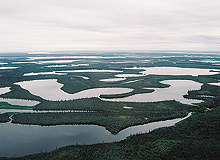
The Mackenzie gas project includes the construction of a 1,196km pipeline along the Mackenzie Valley. This 30in pipeline will have the capacity to transport 1.2 billion cubic feet natural gas per day. The project cost is estimated at $16.2bn.
The pipeline will connect natural gas fields in the Mackenzie delta to markets in Canada and the US.
Regulatory applications for the project were submitted in 2004 and the project was approved in December 2009. Construction work on the project is expected to start in 2013 and be completed by 2016.
The project was proposed almost 25 years ago but met with opposition due to its environmental impact on the aboriginal groups in Canada’s Northwest Territories. Environmental impact studies, however, indicated that the project will not have any adverse impact on these groups.
Design
Natural gas and natural gas liquids (NGLs) produced from the Taglu, Niglintgak and Parsons Lake fields will be transported to a gas processing plant near Inuvik. A system of 190km long gas gathering pipelines called the Mackenzie Gathering System will transport the gas and the NGLs.
The Inuvik gas processing facility will separate NGLs such as butane and pentane from the natural gas. The production rate of NGLs is expected to be 12,000-15,000 barrels per day.
A 457km 10in NGLs pipeline will be laid from the Inuvik processing facility to Norman Wells to transport the NGLs to the Enbridge pipeline.
Natural gas from the Inuvik processing facility will be transported to north-western Alberta through the Mackenzie Valley Pipeline.
Mackenzie project contractors
A joint venture of Colt WorleyParsons and KBR was awarded the contract to provide preliminary engineering services for the project. The JV carried out engineering services for the transmission pipelines, compression stations and the gas gathering system.
AMEC carried out environmental field studies for the project. The company also aided in preparing the environment impact assessment draft and provided its services during the regulatory process.
Reserves
The Mackenzie delta is thought to contain large reserves of natural gas. The major natural gas fields in the delta – Taglu, Parsons Lake and Niglintgak — together are expected to produce 800 million cubic feet of gas per day.
The Taglu field was discovered in 1971 and is estimated to have three trillion cubic feet of natural gas reserves. It is owned and operated by Imperial Oil Resources Ventures.
Discovered in 1972, the Parsons Lake field contains 2.1 trillion cubic feet of natural gas. ConocoPhillips Canada holds 75% interest in the field and the remaining 25% is held by ExxonMobil Canada.
The Niglintgak field was discovered in 1973 and is owned and operated by Shell Canada. It is estimated to have one trillion cubic feet of natural gas reserves.
Additional fields are being explored and are expected to be connected to the pipeline. The Mackenzie pipeline will also be connected to an existing gas pipeline in north-western Alberta.
Pipeline route
The pipeline will start from the Mackenzie delta and go through Inuvik, Fort Good Hope, Norman Wells, Tulita, Wrigley, Fort Simpson, Jean Marie River, Trout Lake and terminate at Alberta. The pipeline will interconnect with the NGTL pipeline in Alberta.
Facilities
Three compressor stations are part of the project and will be located at Loon River North, Great Bear River and River Between Two Mountains. A heater station will be situated at Trout Lake winter road and a pigging facility at Storm Hills.
Partners
Imperial Oil, ConocoPhillips, ExxonMobil and Shell Canada are the major partners in the Mackenzie project. In addition, a group representing the aboriginal people of Canada’s Northwest Territories, called Aboriginal Pipeline Group (APG), is also a partner in the project. APG can acquire one third stake in the project.
Imperial Oil will build and operate the gas gathering system and the pipeline. The production facilities at Parsons Lake will be built and constructed by ConocoPhillips. Shell will be responsible for building and operating the production facilities at Niglintgak.

